For freeskier Chris Benchetler of Mammoth, Calif., skiing is about finding beautiful lines in work and art. First drawn to slope-style competition and then on to filming with Poor Boys Productions, he realized he could make a living doing the sport he loved. And when Atomic offered him the opportunity to design his first pair of skis for the 08/09 winter season—The Bent Chetler—he was able to explore another side to his career, one rooted in artistic creativity. Diving into creating the graphics for topsheets opened a world in which he could express his appreciation for the sport through digital art. We caught up with Benchetler to hear more about his artwork and where it’s taken him in his ski career.
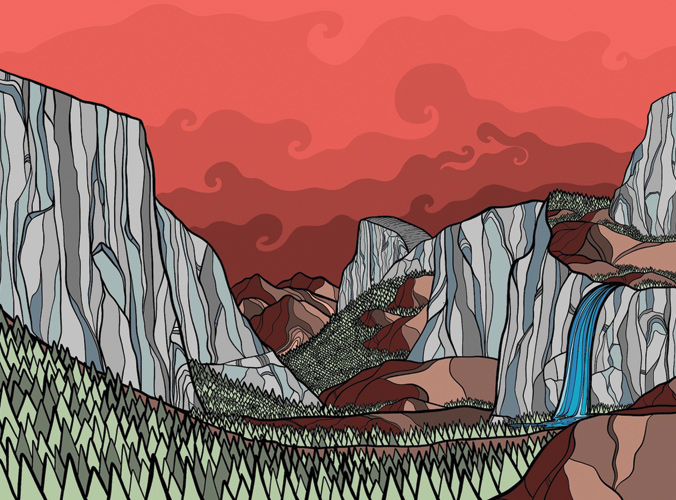
Image Title: Yosemite Valley Under Fire Skies – “The valley holds endless inspiration for my love for climbing, and this is an iconic view of El Cap and Half Dome.” —Chris Benchetler
BCM: How did you get a start as an artist?
Chris Benchetler: Growing up, I would draw and doodle on school homework, but I didn’t consider myself an artist, and I still have trouble with that. But it’s becoming more of a thing in my life, obviously. I started off with no real intentions and no proper classes or studying, but when I had the opportunity to create my first ski graphic, my art blossomed into what it is today.
BCM: What was that learning process like?
CB: It was a culmination of things. I broke my collarbone right when I signed with Atomic, and we had already started developing the ski, so it came down to graphics, I thought, “Well, I already know how to draw so maybe I can take this on.” I did have some down time with my injury.
I don’t have a particular medium that I work in, but I think I do the best work with pen—line drawings—so I went that route with my first ski graphic. I also needed to learn Illustrator and Photoshop—and that process is still going on today and remains very consuming, because digital art is very different from drawing something on a piece of paper. I mocked up my idea for that first ski and then worked with a designer at Atomic to land on something we were both happy with. As the years have progressed, I’ve taught my self more and more about these programs and about digital painting.
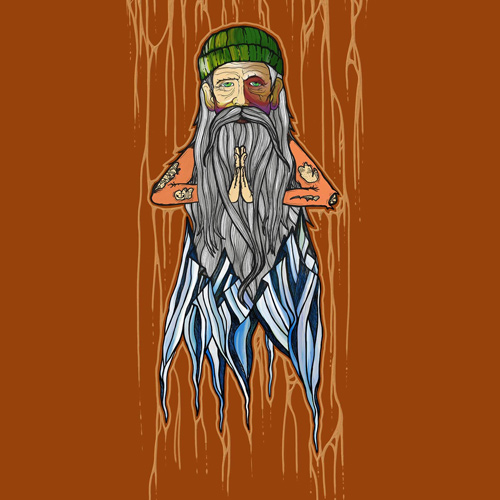
Image Title: Old Man Winter Praying For Snow – “This was painted after the five-year drought in Cali and made it on my ski graphic that next season.” —Chris Benchetler
BCM: How has your style evolved over the year?
CB: I spend a ton of time outdoors; that’s where I’m happiest—surfing, skiing and climbing—so inevitably, my environment and surroundings are my main inspiration. As I’ve aged, I’ve done fewer characters and cartoons and more landscape inspired work.

“This is another mural collaboration, once again with Skye, for my GoPro project ‘Chasing AdVANture’ and ended up on the side of my van ‘The Stealthy Marmot.’” —Chris Benchetler
BCM: How does your home near Mammoth, Calif. influence your work?
CB: It’s an influence in a number of ways. For instance, coloring and the lighting in the Eastern Sierra are pretty dramatic. Sunrise and sunset are always beautiful, and the jagged peaks, like the Minarets in my backyard, are always something I enjoy looking at. I live in a place that’s very multi-dimensional—I’m close to the coast and I love surfing, so I tend to draw waves a lot, and the mountains are big and we also have amazing desert landscapes and rock climbing—so I just mix it all in. And then I’ve been fortunate enough to travel quite a bit, so I take inspiration from anywhere and everywhere.
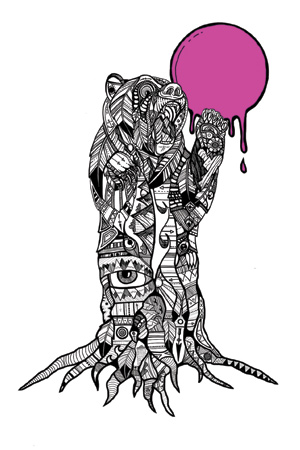
Image Title: Bear – “I did a few spirit animals with pen, and this one made it on a ski graphic a few years back.” —Chris Benchetler

Image Title: Elephant
BCM: When you’re out skiing, do you log things mentally and think about what you’re seeing from an artist’s perspective?
CB: I would say that backcountry skiing is very artistic and always has been for me. That’s what draws me to it so much. With skiing, you get to draw a line down the mountain however you see it, so I’ve always related the two in terms of creativity. I can’t really pinpoint a way to describe how I see the mountains, but one—being in the mountains—definitely influences the other—art.
BCM: What does you process look like?
CB: It’s very broad. I did a 70-foot mural on the side of the evo.com building recently. That involved spray-paint, so that was a wild experience. And Mammoth just hired me to do the trophies for the Grand Prix, so I painted a bunch of skateboards with acrylic paint pen. So, I’ve dabbled in a lot of mediums.
I can’t say I’ve done art for fun really. It’s usually for a project or for a graphic, because if I have free time, I’m outside.
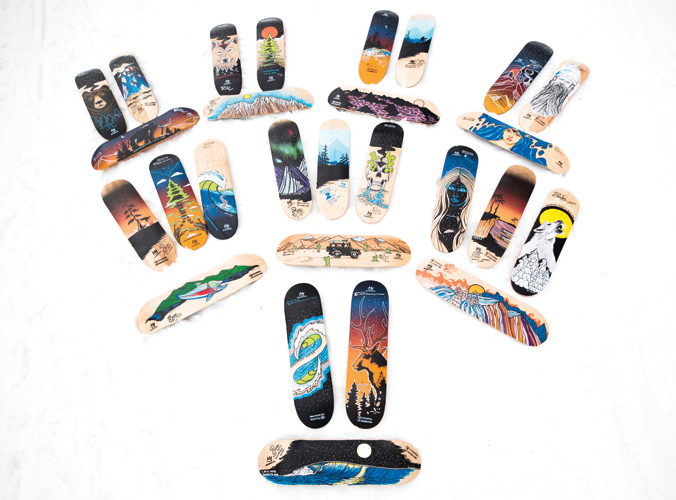
Skateboards for the Mammoth Mt. Grand Prix. [Photo] Chris Benchetler
CB: There are so many incredible artists that never get discovered, and I have been given so many opportunities and so many platforms to express myself, and that’s why I sometimes struggle with calling myself an artist. There are people who devote their lives to their work and have studied art history and learn all the different mediums and have insane talent. I realize how lucky I am.
BCM: Where do you think your art’s going to take you in the future?
CB: I don’t know that it will ever become the main driving force I my life, but I think I will always do it. I’ve had a couple of opportunities to do large-scale murals, and my friend who joined me on the evo.com Steattle piece is a large scale muralist by trade, so I’ll probably do another project or two with him. It was unique to be able to get up on a scissor lift. Most art you create is going to go up on a wall, but with a mural, everyone who walks by is going to have a different interpretation of what you’re doing. I would love to do a mural again with Skye Walker, but I don’t think I would ever do one on my own.
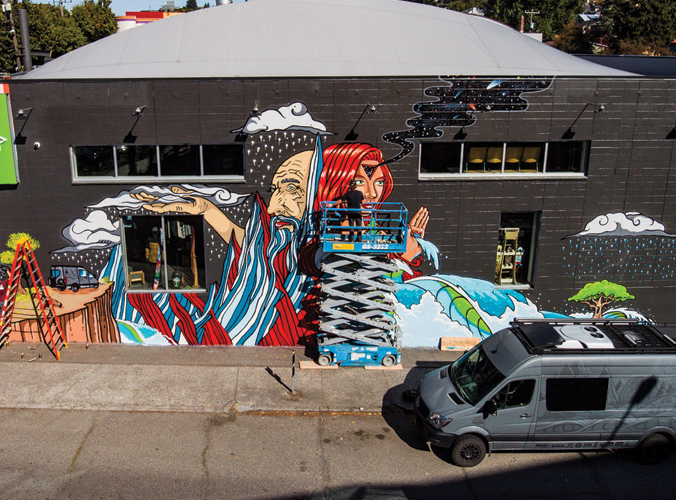
Image Title: Mural on Evo Seattle – “My first large scale mural. It was a very cool collaboration with Skye Walker using spray paint. I painted the left “Old Man Winter” and Skye painted the righthand image, “Mother Nature.” We tried to intertwine and blend the characters together. It’s been rad collaborating with Skye since we share similar passions, views and have very similar painting styles.” —Chris Benchetler
I did, however, do a smaller mural in our baby room at home—my wife and I are expecting a child, and she wanted a mural. So I’ll do stuff like that maybe for friends, but if I do something big again I would want to do that with Skye.
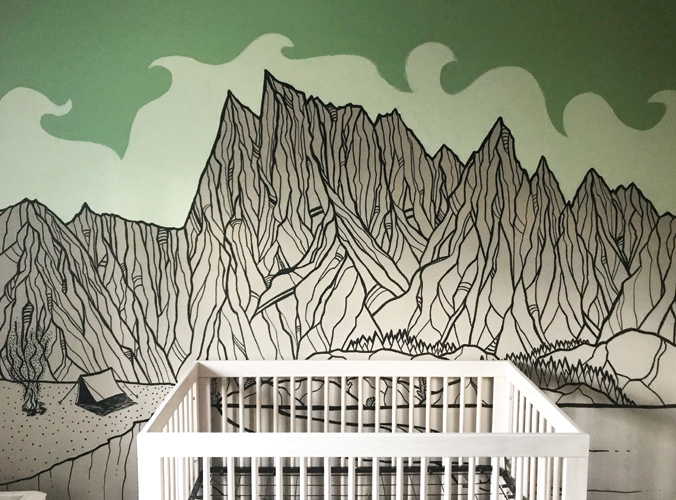
Image Title: Nursery Mural – “This is in our soon-to-be baby’s room. It’s of the Minarets, which is an iconic mountain range next to Mammoth Mountain.” —Chris Benchetler
BCM: Do you have a specific method for designing topsheets?
CB: No, I’m pretty bad about it. I should design them in the shape of a ski and really have the concept of what it should look like beforehand, but inevitably I end up just drawing stuff that I’m inspired by and afterward I try to squeeze it onto a ski.
BCM: What’s it like not having any one medium you gravitate to?
CB: Since this isn’t my profession, I’m not attached to the perfection of it. I realize that art is never perfect either, and that’s the beauty of it, but I think a lot of people probably want to master their craft, and I don’t consider myself a master. I’m always learning and always evolving. Since I’m not overly attached to my art, it’s pretty easy for me to dive into a new medium and try it out; see how it like it.
—
To view more of Benchetler’s work, visit chrisbenchetler.com.










Related posts:
Skintrack Sketches: Gianna Andrews takes the silver linings in life and paints them
Skintrack Sketches: Mimi Kvinge looks to balance authentic artistic identity and brand
Skintrack Sketches: Lori LaBissoniere finds her inspiration in the Pacific Northwest's remote landsc…
Skintrack Sketches: Artist Lindsay Dew counts on memory to create mountainscapes